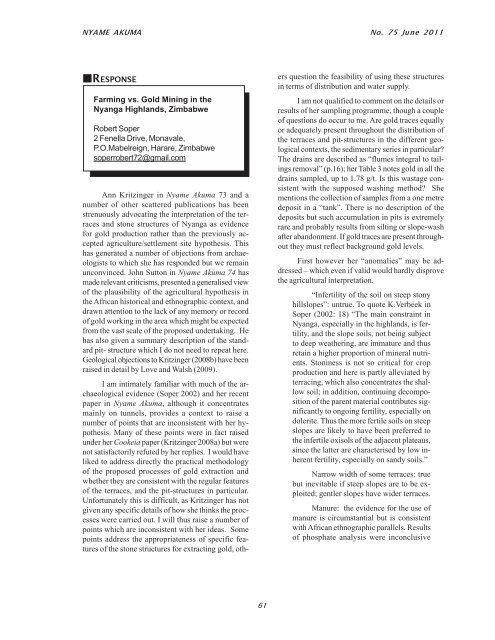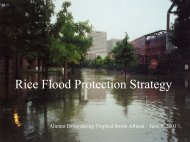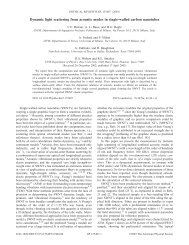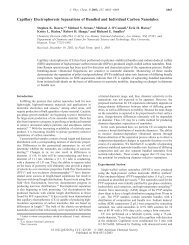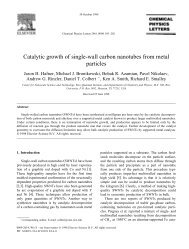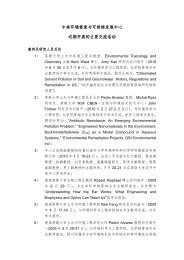Farming vs. Gold Mining in the Nyanga Highlands
Farming vs. Gold Mining in the Nyanga Highlands
Farming vs. Gold Mining in the Nyanga Highlands
Create successful ePaper yourself
Turn your PDF publications into a flip-book with our unique Google optimized e-Paper software.
NYAME AKUMA No. 75 June 2011<br />
RESPONSE<br />
<strong>Farm<strong>in</strong>g</strong> <strong>vs</strong>. <strong>Gold</strong> <strong>M<strong>in</strong><strong>in</strong>g</strong> <strong>in</strong> <strong>the</strong><br />
<strong>Nyanga</strong> <strong>Highlands</strong>, Zimbabwe<br />
Robert Soper<br />
2 Fenella Drive, Monavale,<br />
P.O.Mabelreign, Harare, Zimbabwe<br />
soperrobert72@gmail.com<br />
Ann Kritz<strong>in</strong>ger <strong>in</strong> Nyame Akuma 73 and a<br />
number of o<strong>the</strong>r scattered publications has been<br />
strenuously advocat<strong>in</strong>g <strong>the</strong> <strong>in</strong>terpretation of <strong>the</strong> terraces<br />
and stone structures of <strong>Nyanga</strong> as evidence<br />
for gold production ra<strong>the</strong>r than <strong>the</strong> previously accepted<br />
agriculture/settlement site hypo<strong>the</strong>sis. This<br />
has generated a number of objections from archaeologists<br />
to which she has responded but we rema<strong>in</strong><br />
unconv<strong>in</strong>ced. John Sutton <strong>in</strong> Nyame Akuma 74 has<br />
made relevant criticisms, presented a generalised view<br />
of <strong>the</strong> plausibility of <strong>the</strong> agricultural hypo<strong>the</strong>sis <strong>in</strong><br />
<strong>the</strong> African historical and ethnographic context, and<br />
drawn attention to <strong>the</strong> lack of any memory or record<br />
of gold work<strong>in</strong>g <strong>in</strong> <strong>the</strong> area which might be expected<br />
from <strong>the</strong> vast scale of <strong>the</strong> proposed undertak<strong>in</strong>g. He<br />
has also given a summary description of <strong>the</strong> standard<br />
pit- structure which I do not need to repeat here.<br />
Geological objections to Kritz<strong>in</strong>ger (2008b) have been<br />
raised <strong>in</strong> detail by Love and Walsh (2009).<br />
I am <strong>in</strong>timately familiar with much of <strong>the</strong> archaeological<br />
evidence (Soper 2002) and her recent<br />
paper <strong>in</strong> Nyame Akuma, although it concentrates<br />
ma<strong>in</strong>ly on tunnels, provides a context to raise a<br />
number of po<strong>in</strong>ts that are <strong>in</strong>consistent with her hypo<strong>the</strong>sis.<br />
Many of <strong>the</strong>se po<strong>in</strong>ts were <strong>in</strong> fact raised<br />
under her Cookeia paper (Kritz<strong>in</strong>ger 2008a) but were<br />
not satisfactorily refuted by her replies. I would have<br />
liked to address directly <strong>the</strong> practical methodology<br />
of <strong>the</strong> proposed processes of gold extraction and<br />
whe<strong>the</strong>r <strong>the</strong>y are consistent with <strong>the</strong> regular features<br />
of <strong>the</strong> terraces, and <strong>the</strong> pit-structures <strong>in</strong> particular.<br />
Unfortunately this is difficult, as Kritz<strong>in</strong>ger has not<br />
given any specific details of how she th<strong>in</strong>ks <strong>the</strong> processes<br />
were carried out. I will thus raise a number of<br />
po<strong>in</strong>ts which are <strong>in</strong>consistent with her ideas. Some<br />
po<strong>in</strong>ts address <strong>the</strong> appropriateness of specific features<br />
of <strong>the</strong> stone structures for extract<strong>in</strong>g gold, oth-<br />
61<br />
ers question <strong>the</strong> feasibility of us<strong>in</strong>g <strong>the</strong>se structures<br />
<strong>in</strong> terms of distribution and water supply.<br />
I am not qualified to comment on <strong>the</strong> details or<br />
results of her sampl<strong>in</strong>g programme, though a couple<br />
of questions do occur to me. Are gold traces equally<br />
or adequately present throughout <strong>the</strong> distribution of<br />
<strong>the</strong> terraces and pit-structures <strong>in</strong> <strong>the</strong> different geological<br />
contexts, <strong>the</strong> sedimentary series <strong>in</strong> particular?<br />
The dra<strong>in</strong>s are described as “flumes <strong>in</strong>tegral to tail<strong>in</strong>gs<br />
removal” (p.16); her Table 3 notes gold <strong>in</strong> all <strong>the</strong><br />
dra<strong>in</strong>s sampled, up to 1.78 g/t. Is this wastage consistent<br />
with <strong>the</strong> supposed wash<strong>in</strong>g method? She<br />
mentions <strong>the</strong> collection of samples from a one metre<br />
deposit <strong>in</strong> a “tank”. There is no description of <strong>the</strong><br />
deposits but such accumulation <strong>in</strong> pits is extremely<br />
rare and probably results from silt<strong>in</strong>g or slope-wash<br />
after abandonment. If gold traces are present throughout<br />
<strong>the</strong>y must reflect background gold levels.<br />
First however her “anomalies” may be addressed<br />
– which even if valid would hardly disprove<br />
<strong>the</strong> agricultural <strong>in</strong>terpretation.<br />
“Infertility of <strong>the</strong> soil on steep stony<br />
hillslopes”: untrue. To quote K.Verbeek <strong>in</strong><br />
Soper (2002: 18) “The ma<strong>in</strong> constra<strong>in</strong>t <strong>in</strong><br />
<strong>Nyanga</strong>, especially <strong>in</strong> <strong>the</strong> highlands, is fertility,<br />
and <strong>the</strong> slope soils, not be<strong>in</strong>g subject<br />
to deep wea<strong>the</strong>r<strong>in</strong>g, are immature and thus<br />
reta<strong>in</strong> a higher proportion of m<strong>in</strong>eral nutrients.<br />
Ston<strong>in</strong>ess is not so critical for crop<br />
production and here is partly alleviated by<br />
terrac<strong>in</strong>g, which also concentrates <strong>the</strong> shallow<br />
soil; <strong>in</strong> addition, cont<strong>in</strong>u<strong>in</strong>g decomposition<br />
of <strong>the</strong> parent material contributes significantly<br />
to ongo<strong>in</strong>g fertility, especially on<br />
dolerite. Thus <strong>the</strong> more fertile soils on steep<br />
slopes are likely to have been preferred to<br />
<strong>the</strong> <strong>in</strong>fertile oxisols of <strong>the</strong> adjacent plateaus,<br />
s<strong>in</strong>ce <strong>the</strong> latter are characterised by low <strong>in</strong>herent<br />
fertility, especially on sandy soils.”<br />
Narrow width of some terraces: true<br />
but <strong>in</strong>evitable if steep slopes are to be exploited;<br />
gentler slopes have wider terraces.<br />
Manure: <strong>the</strong> evidence for <strong>the</strong> use of<br />
manure is circumstantial but is consistent<br />
with African ethnographic parallels. Results<br />
of phosphate analysis were <strong>in</strong>conclusive
NYAME AKUMA No. 75 June 2011<br />
and do not negate use of manure. Any protection<br />
of crops from wild animals would<br />
have been <strong>in</strong> organic materials which would<br />
not survive.<br />
Consistent presence of quartz: occurrence<br />
of quartz was not an aspect of my own<br />
research but some comments are <strong>in</strong> order.<br />
Ve<strong>in</strong> quartz and quartz rubble is to be expected<br />
on terraces if occurr<strong>in</strong>g <strong>in</strong> <strong>the</strong> local<br />
geology. If concentrations of “crushed<br />
quartz” were consistently associated with<br />
all pit-structures, I like to th<strong>in</strong>k I would have<br />
noticed it. Her figure 5 seems to show<br />
rounded sand gra<strong>in</strong>s ra<strong>the</strong>r than <strong>the</strong> sharp<br />
angles one might expect from crush<strong>in</strong>g. I<br />
have observed heaps of smallish wea<strong>the</strong>red<br />
fragments of quartz, around a couple of metres<br />
<strong>in</strong> diameter and ten or fifteen centimetres<br />
high, localised on relatively level<br />
unterraced land. I had tentatively <strong>in</strong>terpreted<br />
<strong>the</strong>m as stone clearance dur<strong>in</strong>g cultivation.<br />
Design of pit-structures: <strong>the</strong> “pr<strong>in</strong>ciples<br />
for recovery of a heavy metal by gravity<br />
concentration” are not specified, but can<br />
hardly be exclusive to any o<strong>the</strong>r function.<br />
All <strong>the</strong> regular features of <strong>the</strong>se structures<br />
are equally or more consistent with family<br />
homesteads with livestock; <strong>the</strong>re is no<br />
anomaly here. The term “pit-structure” is not<br />
a misnomer but a simple descriptive label<br />
co<strong>in</strong>ed by Roger Summers (1959), avoid<strong>in</strong>g<br />
any assumption of function. Kritz<strong>in</strong>ger’s<br />
“hydraulic tank systems” leaps to a conclusion<br />
of function which is open to doubt (see<br />
below), symptomatic of <strong>the</strong> whole gold hypo<strong>the</strong>sis.<br />
If <strong>the</strong>se structures she calls “hydraulic tank<br />
systems” (archaeologically known as “pit-structures”<br />
and “pit-enclosures”) were specifically designed and<br />
built for <strong>the</strong> extraction of gold, all <strong>the</strong>ir characteristic<br />
features must be explicable <strong>in</strong> practical terms throughout<br />
<strong>the</strong>ir distribution and <strong>the</strong> distribution must co<strong>in</strong>cide<br />
with workable levels of gold. The latter may be<br />
<strong>the</strong> case but rema<strong>in</strong>s to be demonstrated. It is not<br />
mean<strong>in</strong>gful to select atypical examples to support a<br />
special hypo<strong>the</strong>sis as she has done <strong>in</strong> <strong>the</strong> case of<br />
restricted tunnel entrances.<br />
62<br />
Although she does not cover o<strong>the</strong>r elements<br />
of <strong>the</strong> “tank system” <strong>in</strong> this paper, <strong>the</strong>y merit some<br />
comment. The slots <strong>in</strong> tunnel roofs are hardly<br />
“hopper-like” (though on her figure 3 she labels it<br />
“ventilator”), be<strong>in</strong>g only around 15cm wide and 50cm<br />
long, cut through <strong>the</strong> floor of <strong>the</strong> house above, which<br />
is divided by a low wall, one half be<strong>in</strong>g stone paved<br />
and <strong>the</strong> o<strong>the</strong>r half, at a slightly higher level, hav<strong>in</strong>g a<br />
plastered floor with a hearth. This is reasonably<br />
<strong>in</strong>terpreted as a kitchen/liv<strong>in</strong>g area with accommodation<br />
for small stock such as goats, a traditional<br />
practice <strong>in</strong> this area. The slot is more conv<strong>in</strong>c<strong>in</strong>gly<br />
expla<strong>in</strong>ed as a device through which to drop poles to<br />
block <strong>the</strong> tunnel. Presumably what she calls “work<br />
bays” are what I <strong>in</strong>terpret as house bays, low rough<br />
stone walls surround<strong>in</strong>g clay-walled houses. Her<br />
“oven-type structures” seem to be <strong>the</strong> raised platforms<br />
likely to have supported storage huts; <strong>the</strong> clay<br />
floors of <strong>the</strong>se show no regular evidence of bak<strong>in</strong>g.<br />
The “heavy duty gr<strong>in</strong>d<strong>in</strong>g equipment” consists of<br />
normal gr<strong>in</strong>d<strong>in</strong>g stones for gra<strong>in</strong> and <strong>in</strong> some cases<br />
comparable gr<strong>in</strong>d<strong>in</strong>g hollows <strong>in</strong> adjacent rock surfaces.<br />
To return to <strong>the</strong> focus of <strong>the</strong> present paper: <strong>the</strong><br />
tunnels.<br />
“Restrictive dimensions of uphill entrances”.<br />
This is not a constant feature; <strong>the</strong>re are plenty of full<br />
size entrances and any restrictions are likely to be<br />
due to siltation after abandonment, which appears to<br />
be <strong>the</strong> case <strong>in</strong> her figure 3. S<strong>in</strong>ce many tunnels are<br />
not restricted this cannot be a critical feature, so any<br />
restriction, even if it can be shown to be deliberate,<br />
can only be a modification.<br />
She has not expla<strong>in</strong>ed <strong>the</strong> very standard dimensions<br />
of <strong>the</strong> tunnels, 50cm wide and 1.10m high,<br />
plus or m<strong>in</strong>us about 10cm (observation of <strong>the</strong> dimensions,<br />
not statistically calculated). The width may be<br />
a practical measure, but why <strong>the</strong> height of 1.10m?<br />
Indeed why should <strong>the</strong>y be roofed at all if only for<br />
channell<strong>in</strong>g water flow? Her suggestion that <strong>the</strong> roof<br />
would ensure <strong>the</strong> provision of clean water (2008:26)<br />
is unconv<strong>in</strong>c<strong>in</strong>g; water from artificial furrows would<br />
generally already be clean except after heavy ra<strong>in</strong>fall,<br />
while slope wash from such ra<strong>in</strong>fall would already be<br />
muddy and <strong>the</strong>re is no <strong>in</strong>dication of settl<strong>in</strong>g tanks to<br />
reduce this. The consistent height requires explanation.<br />
This of course also applies to <strong>the</strong> dwarf cattle<br />
<strong>in</strong>terpretation. One explanation could be that <strong>the</strong> tun-
NYAME AKUMA No. 75 June 2011<br />
nels were designed to admit only dwarf cattle, exclud<strong>in</strong>g<br />
larger beasts, perhaps as a selective breed<strong>in</strong>g<br />
strategy, emphasiz<strong>in</strong>g <strong>the</strong> cultural or practical<br />
value placed on <strong>the</strong> breed.<br />
The tunnel curvature has a structural reason: if<br />
you want an entrance tunnel with down gradient to<br />
flush out <strong>the</strong> pit from <strong>the</strong> upper side, (one po<strong>in</strong>t at<br />
least on which we agree), you can only curve it <strong>in</strong><br />
from <strong>the</strong> side of <strong>the</strong> platform. A straight entrance from<br />
<strong>the</strong> upper side of <strong>the</strong> platform would require considerable<br />
excavation, often impossible on shallow bedrock.<br />
A more <strong>in</strong>terest<strong>in</strong>g po<strong>in</strong>t is <strong>the</strong> left-hand curvature<br />
<strong>in</strong>to <strong>the</strong> pit which has very few exceptions. This<br />
can have no functional advantage over a right-hand<br />
curve and must be culturally determ<strong>in</strong>ed.<br />
Her “review of tunnel statistics 1900—2000” is<br />
a useful summary but hardly adds to her arguments.<br />
Her po<strong>in</strong>t about <strong>the</strong> “bov<strong>in</strong>e phobia for dark holes”,<br />
militat<strong>in</strong>g aga<strong>in</strong>st <strong>the</strong> use of <strong>the</strong> pits for cattle, is doubtless<br />
true for cattle accustomed to liv<strong>in</strong>g <strong>in</strong> open fields,<br />
but calves mov<strong>in</strong>g <strong>in</strong> and out of tunnels from birth<br />
would surely have been familiarised and have no difficulty.<br />
John Sutton has discussed <strong>the</strong> use of <strong>the</strong> pits<br />
for stall feed<strong>in</strong>g of cattle and accumulation of<br />
manure. I have proposed that <strong>in</strong> some cases <strong>the</strong> manure<br />
was not accumulated, but flushed out as slurry<br />
and caught below <strong>the</strong> dra<strong>in</strong> from <strong>the</strong> pit <strong>in</strong> a small<br />
dammed bas<strong>in</strong>, for immediate fertilisation of a homestead<br />
garden, reta<strong>in</strong>ed by a radial wall from <strong>the</strong> side<br />
of <strong>the</strong> platform. I may also po<strong>in</strong>t out that <strong>the</strong> pits<br />
provide a well protected accommodation for <strong>the</strong> cattle<br />
with<strong>in</strong> <strong>the</strong> homestead, sheltered from <strong>the</strong> cold<br />
w<strong>in</strong>ds of w<strong>in</strong>ter.<br />
She implies that <strong>the</strong> gold wash<strong>in</strong>g started<br />
with<strong>in</strong> <strong>the</strong> tunnel and has one sample which might<br />
support this. Any gold deposited <strong>in</strong> <strong>the</strong> tunnel would<br />
have to be recovered by crawl<strong>in</strong>g <strong>in</strong> <strong>the</strong> dark from <strong>the</strong><br />
“tank”, an unlikely <strong>in</strong>convenience.<br />
“Tanks”. Firstly, <strong>the</strong>re is <strong>the</strong> critical but as yet<br />
unanswered question of whe<strong>the</strong>r <strong>the</strong> pits would hold<br />
water at all. The dry-stone fac<strong>in</strong>g of <strong>the</strong> pit wall would<br />
need to be backed by an impermeable re<strong>in</strong>forcement<br />
of clay, and I am not aware of any excavation of <strong>the</strong><br />
platform fill which could prove or disprove this.<br />
Although firmly conv<strong>in</strong>ced that <strong>the</strong>se are tanks,<br />
she has not conjectured on <strong>the</strong>ir function or how<br />
<strong>the</strong>y could be filled and operated. Plugg<strong>in</strong>g <strong>the</strong> mouth<br />
63<br />
of <strong>the</strong> dra<strong>in</strong> to reta<strong>in</strong> water would be difficult but<br />
perhaps possible, but unplugg<strong>in</strong>g it under a couple<br />
of metres of water and controll<strong>in</strong>g <strong>the</strong> outflow would<br />
be problematic. There is one case where a loose stone<br />
slab covers <strong>the</strong> mouth of <strong>the</strong> dra<strong>in</strong> (Soper 2002:178)<br />
but this would be necessary <strong>in</strong> <strong>the</strong> accumulation of<br />
manure to prevent blockage. No gold wash<strong>in</strong>g could<br />
take place while <strong>the</strong> tank was full of water, back<strong>in</strong>g up<br />
<strong>the</strong> tunnel. Water storage for gold wash<strong>in</strong>g below<br />
<strong>the</strong> dra<strong>in</strong> would seem a possibility but this has not<br />
been suggested, nor is <strong>the</strong>re any evidence for appropriate<br />
sluices, some <strong>in</strong>dication of which would surely<br />
have survived. What else might such storage be for?<br />
Perhaps it could have been for flush<strong>in</strong>g away any<br />
tail<strong>in</strong>gs below <strong>the</strong> dra<strong>in</strong> but <strong>the</strong> presence of small<br />
dammed bas<strong>in</strong>s below <strong>the</strong> dra<strong>in</strong> <strong>in</strong> some cases is <strong>in</strong>consistent;<br />
<strong>the</strong>y would rapidly silt up with any tail<strong>in</strong>gs<br />
and <strong>in</strong> any case would also be flushed away.<br />
Kritz<strong>in</strong>ger’s figure 2 quotes me as not<strong>in</strong>g a “complex<br />
system of ditches and hollows” below <strong>the</strong> pit-structures,<br />
but omits <strong>the</strong> preced<strong>in</strong>g “<strong>in</strong> some cases”; such<br />
cases are relatively rare and <strong>in</strong>dicate <strong>the</strong> reuse of<br />
water or perhaps <strong>the</strong> direction of flushed slurry manure<br />
to lower gardens.<br />
Water. An adequate controlled stream of water<br />
is an essential requirement for <strong>the</strong> gravity recovery<br />
of heavy m<strong>in</strong>erals, whereas for occupied farm<strong>in</strong>g<br />
homesteads a supply of flow<strong>in</strong>g water would be a<br />
useful asset but not essential. Kritz<strong>in</strong>ger has not yet<br />
addressed <strong>the</strong> full implications of water supply. It<br />
would be useful to have some estimates of <strong>the</strong> volume<br />
of water and rate of flow required for wash<strong>in</strong>g<br />
different materials, but some relevant po<strong>in</strong>ts can be<br />
discussed. The construction of massive pit-structures<br />
can be regarded as a capital <strong>in</strong>vestment, <strong>the</strong><br />
utilisation of which would require a regular flow of<br />
water to make <strong>the</strong>m economically viable. This would<br />
have to apply to all pits if <strong>the</strong>y were for gold extraction.<br />
Certa<strong>in</strong>ly some of <strong>the</strong> pits were served by artificial<br />
furrows, traces of which are still detectable. Many<br />
more are so sited topographically that <strong>the</strong>y could<br />
have been so served, but o<strong>the</strong>rs could not. Reliance<br />
on ra<strong>in</strong>fall would hardly be adequate; local catchments<br />
are often limited, and sporadic ra<strong>in</strong>storms restricted<br />
to <strong>the</strong> few months of <strong>the</strong> ra<strong>in</strong>y season would<br />
not suffice or provide a steady flow. In o<strong>the</strong>r papers<br />
she has suggested that <strong>the</strong> radial walls from some<br />
platforms were for direct<strong>in</strong>g slope wash but <strong>the</strong>y are<br />
not so positioned; all are below <strong>the</strong> tunnel entrances
NYAME AKUMA No. 75 June 2011<br />
and many are on <strong>the</strong> opposite side of <strong>the</strong> platform.<br />
The retention of soil for homestead gardens is a more<br />
consistent <strong>in</strong>terpretation.<br />
Water supply applies particularly to <strong>the</strong> variant<br />
structures of lowland Ziwa, dubbed pit-enclosures,<br />
which have o<strong>the</strong>r features which are <strong>in</strong>consistent.<br />
The platforms of <strong>the</strong>se structures are lower<br />
and <strong>the</strong> pits shallower and smaller (average diameter<br />
3.20m) than <strong>the</strong> upland pit-structures, with <strong>the</strong> usual<br />
dra<strong>in</strong> below (and no radial walls). The upper side of<br />
<strong>the</strong> platform has an enclosure wall around 1.20m high,<br />
greatly thickened around a straight entrance passage<br />
which is often l<strong>in</strong>telled with stone slabs, of <strong>the</strong> familiar<br />
height and width. These passages can be closed<br />
by a built-<strong>in</strong> draw bar, comparable to <strong>the</strong> upland tunnels<br />
closable by dropp<strong>in</strong>g poles through <strong>the</strong> slot.<br />
The tunnel to <strong>the</strong> pit is generally straight with no slot<br />
and starts with<strong>in</strong> <strong>the</strong> enclosure near <strong>the</strong> entrance.<br />
Not all tunnels are roofed; roof slabs could have been<br />
removed for reuse, or <strong>the</strong> l<strong>in</strong>telled enclosure entrance<br />
already provided <strong>the</strong> height restriction. In many cases<br />
<strong>the</strong>se tunnels have been deliberately partly or completely<br />
blocked with stones, which rarely if ever occurs<br />
<strong>in</strong> <strong>the</strong> highland pit-structures. Any water supply<br />
would have to come through <strong>the</strong> entrance passage,<br />
possible but <strong>in</strong>convenient. The majority of such<br />
structures could not be served by furrows. It may<br />
also be noted that many o<strong>the</strong>r Ziwa enclosures have<br />
no pits, though of similar size and shape, with identical<br />
divided houses and raised platforms for storage<br />
huts. These are clearly occupation homesteads, not<br />
<strong>in</strong>dustrial <strong>in</strong>stallations.<br />
There are no pit-structures <strong>in</strong> <strong>the</strong> lowland areas<br />
below <strong>the</strong> nor<strong>the</strong>rn highlands. Here <strong>the</strong> homestead<br />
design is what I have called “double concentric<br />
enclosures” of similar size, with a low and ra<strong>the</strong>r<br />
rough outer wall and a central well-built enclosure,<br />
equivalent to <strong>the</strong> pit <strong>in</strong> size and position. This could<br />
still have accommodated a few cattle (not necessarily<br />
dwarf) but could have no association with gold<br />
extraction.<br />
The same water restrictions apply to <strong>the</strong> terraces<br />
which are not considered <strong>in</strong> her present article,<br />
but which she claims are typical of strip m<strong>in</strong><strong>in</strong>g. The<br />
terraces are not served by water furrows and <strong>the</strong> gentle<br />
longitud<strong>in</strong>al gradients of only one or two degrees<br />
would seem <strong>in</strong>adequate for wash<strong>in</strong>g soil, reliant <strong>in</strong><br />
any case only on sporadic storms. As John Sutton<br />
64<br />
has po<strong>in</strong>ted out, <strong>the</strong> formal construction of <strong>the</strong> double<br />
faced, rubble filled terrace risers would seem<br />
grossly elaborate to protect aga<strong>in</strong>st land slip <strong>in</strong> <strong>the</strong><br />
course of exploitation (Kritz<strong>in</strong>ger 2008: 26). The labour<br />
<strong>in</strong>vested <strong>in</strong> such permanent structures could<br />
only be justified by <strong>the</strong> retention of soil for long<br />
term use and cannot be attributed to <strong>the</strong> one-off stripp<strong>in</strong>g<br />
of soil, even if that were consistent with <strong>the</strong><br />
design. Some terraces on a slope of only a few degrees<br />
are separated by walls a metre or more high, for<br />
<strong>in</strong>stance those adjo<strong>in</strong><strong>in</strong>g <strong>the</strong> site museum at Ziwa.<br />
Labour. Both <strong>the</strong> agricultural and gold hypo<strong>the</strong>ses<br />
must be labour <strong>in</strong>tensive. If <strong>the</strong> pit-structures<br />
were <strong>in</strong>dustrial <strong>in</strong>stallations with “work bays”, ra<strong>the</strong>r<br />
than occupied homesteads, where was this labour<br />
accommodated? Contemporary settlements throughout<br />
<strong>the</strong> area have not been identified and are unlikely<br />
to have been missed.<br />
Altitud<strong>in</strong>al distribution. The altitud<strong>in</strong>al distribution<br />
of <strong>the</strong> terraces and pit-structures, which she<br />
has <strong>in</strong> fact noted <strong>in</strong> ano<strong>the</strong>r article (Kritz<strong>in</strong>ger 2009),<br />
is relevant. The upper limit of terrac<strong>in</strong>g is at about<br />
1700m above sea level, approximately <strong>the</strong> top of <strong>the</strong><br />
ma<strong>in</strong> escarpments; <strong>the</strong> lower limit is not clearly def<strong>in</strong>ed<br />
but <strong>the</strong>y cont<strong>in</strong>ue down <strong>in</strong>to <strong>the</strong> valleys and<br />
lowland ridges to ca. 900m. The standard pit-structures<br />
have a lower limit of 1400m with only 3 recorded<br />
slightly below this. They cont<strong>in</strong>ue up to 1900m, with<br />
“ru<strong>in</strong>ed pit-structures”, apparently earlier prototypes,<br />
up to over 2000m. Thus between 1400 and 1700m<br />
<strong>the</strong>y are directly associated with terraces, but <strong>the</strong><br />
majority are above any terrac<strong>in</strong>g and <strong>the</strong>se may be<br />
quite densely concentrated. Nyangui Forest Block G<br />
for <strong>in</strong>stance has one group of 29 well preserved pits<br />
<strong>in</strong> 11 hectares and ano<strong>the</strong>r group of 25 pits <strong>in</strong> 8 hectares<br />
(Soper 2002: 95). These are easily <strong>in</strong>terpreted as<br />
village communities, not so easily as <strong>in</strong>dustrial build<strong>in</strong>gs.<br />
They could hardly all be supplied with sufficient<br />
raw material for gold extraction or sufficient<br />
water to carry it out, even if all were not <strong>in</strong> use at <strong>the</strong><br />
same time. Kritz<strong>in</strong>ger implies that <strong>the</strong> “tanks” were<br />
for wash<strong>in</strong>g crushed quartz. This would surely not<br />
have been carried up to 200m from <strong>the</strong> terraces and I<br />
do not believe <strong>the</strong>re are sufficient quartz outcrops<br />
above <strong>the</strong> ma<strong>in</strong> escarpments (or probably even <strong>the</strong>re)<br />
to feed so many pit-structures. The extraction of<br />
eluvial gold would require <strong>the</strong> process<strong>in</strong>g of huge<br />
quantities of soil. Kritz<strong>in</strong>ger’s idea of <strong>the</strong> narrow tunnel<br />
slots as “hoppers” could not accommodate this.
NYAME AKUMA No. 75 June 2011<br />
Bulk soil could not be dumped and washed <strong>in</strong> <strong>the</strong><br />
restricted size and circular shape of <strong>the</strong> “tank”, and<br />
so it could only be <strong>in</strong>troduced at <strong>the</strong> tunnel entrance,<br />
which is clearly not designed for this.<br />
Conclusion. While many questions rema<strong>in</strong> to<br />
be answered to clarify <strong>the</strong> practical and social aspects<br />
of <strong>the</strong> agricultural/homestead <strong>in</strong>terpretation,<br />
<strong>the</strong> evidence and <strong>the</strong> po<strong>in</strong>ts raised above are all consistent<br />
with this. The same cannot be said for <strong>the</strong><br />
gold hypo<strong>the</strong>sis which requires <strong>the</strong> selection of evidence<br />
and special plead<strong>in</strong>g.<br />
Bibliography<br />
Kritz<strong>in</strong>ger, A.<br />
2008a <strong>Gold</strong> not Gra<strong>in</strong> – Precolonial harvest <strong>in</strong> <strong>the</strong><br />
terraced hills of Zimbabwe’s Eastern <strong>Highlands</strong>.<br />
Cookeia. National Museums and<br />
Monuments of Zimbabwe, 13.<br />
2008b <strong>Nyanga</strong> archaeology – m<strong>in</strong><strong>in</strong>g perspective<br />
ga<strong>in</strong><strong>in</strong>g ground. Geological Society of Zimbabwe<br />
Newsletter December 2008: 4-8.<br />
2009 Early m<strong>in</strong><strong>in</strong>g and metallurgy <strong>in</strong> Zimbabwe’s<br />
Eastern <strong>Highlands</strong>. <strong>M<strong>in</strong><strong>in</strong>g</strong> History: The<br />
Bullet<strong>in</strong> of <strong>the</strong> Peak District M<strong>in</strong>es Historical<br />
Society Ltd. 17(4): 79-82.<br />
2010 Gradient and soil analysis identify <strong>the</strong> function<br />
of stone-built tunnels <strong>in</strong> <strong>the</strong> archaeology<br />
of <strong>the</strong> eastern <strong>Highlands</strong>, Zimbabwe.<br />
Nyame Akuma 73: 10-17.<br />
65<br />
Love, D. and K. Walsh<br />
2009 <strong>Nyanga</strong> archaeology – no evidence to support<br />
m<strong>in</strong><strong>in</strong>g activity. Geological Society of<br />
Zimbabwe Newsletter February 2009: 18-21.<br />
Soper, R.<br />
2002 <strong>Nyanga</strong>: Ancient Fields, Settlements and<br />
Agricultural History <strong>in</strong> Zimbabwe. London:<br />
British Institute <strong>in</strong> Eastern Africa, Memoir<br />
16.<br />
Summers, R.<br />
1959 Inyanga: prehistoric settlements <strong>in</strong> Sou<strong>the</strong>rn<br />
Rhodesia. Cambridge: Cambridge University<br />
Press.<br />
Sutton J.<br />
2010 <strong>Nyanga</strong> terraces: gra<strong>in</strong> cultivation or gold<br />
m<strong>in</strong><strong>in</strong>g? Nyame Akuma 74: 63-65.


